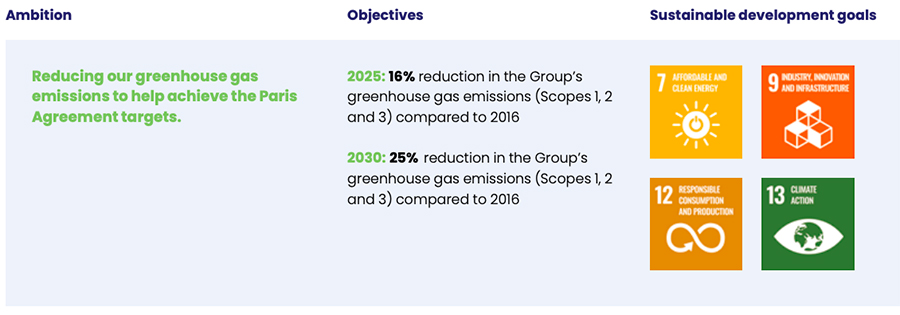Seven years after COP21, limiting global warming to 1.5°C requires global greenhouse gas emissions to be reduced by 43% by 2030. Although many companies have set ambitious targets for reducing their greenhouse gas emissions, the emission levels are continuing to rise.
Mindful of the impact of our activities on the environment, we are committed to reducing our greenhouse gas emissions. We have launched several initiatives to improve waste management, manage our energy consumption effectively and, more generally, reduce environmental impacts throughout the value chain.
Our ambition and objectives
The climate crisis and ecosystem degradation require the pharmaceutical sector, like all industrial stakeholders, to further strengthen its commitments and actions. We need to ramp up the decarbonization of our activities, across the entire value chain for medicinal products.
As part of our Servier Climate Commitment program, we are committed to reducing our greenhouse gas emissions by 25% between 2016 and 2030. In addition, targets have been set for several categories of emissions1, and these targets have been validated by the Science Based Targets Initiative (SBTi) as aligned with a trajectory making it possible to limit climate change to 2°C above pre-industrial average levels.

Find out more about the United Nations’ Sustainable Development Goals (SDGs)
Our achievements and results for 2021/2022
Reducing energy consumption and improving energy performance
To reduce our direct emissions, which represent around 7% of our Group carbon footprint2, we have put in place various actions aimed at reducing our energy consumption and improving the energy performance of our sites. For example, at our brand-named medicine industrial sites, we have deployed “Start & Stop” technologies to only use utilities when necessary. We also take the energy dimension into consideration in our new projects, purchasing industrial equipment which deliver better energy performance levels than before.
4%
In 2021/2022, the Group’s energy consumption levels were reduced by nearly 4% compared to the previous year.
44% of the industrial sites (seven sites: Oril and Gidy in France, Arklow in Ireland, Anpharm in Poland, Toledo in Spain, Cairo in Egypt and Sophyno in Russia), in addition to our Suresnes headquarters in France, are ISO 50001 or ISO 14001 certified. Our objective: to achieve ISO 50001 or ISO 14001 certification for 80% of our industrial and R&D sites by 2025, then 100% by 2030.
Part of the Group’s Scope 1 emissions are linked to vehicles from its fleet, which represent a vital work tool, particularly for medical visitors in many countries. The Servier Group, collaborating with its various partners in this area, is working to build an energy transition strategy for its vehicle fleet adapted to the legal and market characteristics of its various subsidiaries. This is based on actions such as increasing the percentage of hybrid and electric vehicles within the fleet.
Prioritizing electricity from renewable sources
To reduce our Scope 2 emissions, linked to our electricity consumption, we are increasing the percentage of renewable energy within our energy mix from year to year. Currently, four Servier industrial sites, equipped with photovoltaic panels, generate renewable electricity directly at their sites (two sites in Spain, one in Ireland and one in Poland). The two industrial sites in France – Oril and Gidy – and the Jacarepagua site in Brazil are also looking into the possibility of installing panels. In addition, four industrial sites (two sites in Spain, one in Ireland and one in Brazil) source renewable electricity from external suppliers.
In total, five industrial sites have 100% renewable electricity supplies (Arklow in Ireland, Toledo and Madrid in Spain, Jacarepagua and Pharlab in Brazil).
At Group level, renewable electricity represents 13% of our electricity mix. In 2022/2023, to continue increasing the percentage of renewable electricity within our energy mix, we planned to define a Group strategy to source renewable electricity supplies.
Using lower emission means of transport to distribute our medicinal products
We use marine transport as an alternative to air transport in order to prioritize more environmentally responsible means of transport to deliver our medicinal products to our subsidiaries, distribution platforms and direct clients. Between 2021 and 2022, we reduced the volumes transported by plane from our Loiret site (France) and Arklow site (Ireland) by 5.2%, with a shift to marine transport. The tonnage transported by sea, including departures from other sites (Bolbec in France), increased by 25%. In 2021/2022, 45% of intercontinental flows were transported by boat and 55% by plane. The objective for 2022/2023 is to reverse this ratio, transporting 55% of intercontinental flows by boat and 45% by plane.
Offsetting our residual emissions
Lastly, we are offsetting part of our residual emissions, through two projects to avoid greenhouse gas emissions. The first project, “Floresta de Portel” in Brazil, aims to protect a fragile ecosystem and prevent its deforestation. The second project, “Windu Volkani” in Indonesia, involves building a geothermal power plant, contributing to decarbonize the local energy mix.
By 2025, the objective is to offset more than 58,000 tCO2eq, then, by 2030, to offset the equivalent of our residual direct emissions (Scope 1).
30,000
tCO2 eq were offset in 2021/2022.
[1] Servier has set out its commitment with the SBTi to achieve a 25% reduction, between 2016 and 2030, in its Scope 1 and 2 emissions, its Scope 3 emissions relating to capital goods (Category 2), waste generated in operations (Category 5), business travel (Category 6) and employee commuting (Category 7), combined with a 21% reduction in its Scope 3 emissions relating to downstream transportation and distribution (Category 9). Servier is also committed to ensuring that, by 2024, 52% of the Scope 3 emissions relating to Purchased Goods and Services (Category 1) are covered by a commitment by suppliers to reduce greenhouse gas emissions. These objectives are currently being reviewed.
[2] In view of the carbon footprint for 2018/2019.

